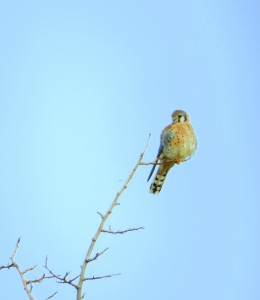
“This is a bird you can only appreciate with binoculars,” said Brad Barker last Saturday. Barker, Conservation Chair for Yokuts Sierra Club, was looking at an American Kestrel while participating in the Audubon Society’s annual Christmas Count.
Though it’s our most common falcon, the diminutive Kestrel is easily overlooked. Its cousin the Peregrine Falcon garners most of the fame and attention not only because of its larger size but also because it is the most prized possession of falconers. Nonetheless, it was a colorful Kestrel that was featured as the “dapple-dawn-drawn Falcon” in Gerard Manley Hopkins famous poem, “The Windhover.”
Whereas the popular name for the powerful Peregrine is “Duck Hawk,” the Kestrel is widely known as the “Sparrow Hawk.” If not for its small size, the American Kestrel would almost certainly be more widely appreciated than the Peregrine, largely because of its beautiful plumage.
Because it’s only about the size of a jay or Robin, the Kestrel’s array of color is too seldom noticed. The male features a steel-gray, orange, black, and white combination of colors superbly suited for its streamlined falcon’s features. Females are less blue-gray and have black barring on their rusty backs.
Despite its nickname, the “Sparrow Hawk” feeds much more commonly on insects than on birds. Kestrels can spot their tiny prey both from their perches and while hovering. Once zeroed-in on a meal, Kestrels swoop with typical falcon efficiency and speed—their top speed is nearly forty miles an hour. Their keen vision also enables them to see into the ultraviolet spectrum, which adds another dimension to their already formidable hunting abilities.
Even though Kestrels are supremely adapted for survival, their numbers are declining. The most threatening factor is loss of the open space that provides prey and foraging ground. Because of their dependence on insects for food, they’re also susceptible to poisoning from pesticides.
In the San Joaquin Valley’s open spaces, look for Kestrels on phone wires, bare tree branches, and fence posts. Bring binoculars.
